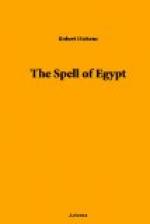The ancient Egyptians made most of their temples in conformity with a single type. The sanctuary was at the heart, the core, of each temple—the sanctuary surrounded by the chambers in which were laid up the precious objects connected with ceremonies and sacrifices. Leading to this core of the temple, which was sometimes called “the divine house,” were various halls the roofs of which were supported by columns—those hypostyle halls which one sees perpetually in Egypt. Before the first of these halls was a courtyard surrounded by a colonnade. In the courtyard the priests of the temple assembled. The people were allowed to enter the colonnade. A gateway with towers gave entrance to the courtyard. If one visits many of the Egyptian temples, one soon becomes aware of the subtlety, combined with a sort of high simplicity and sense of mystery and poetry, of these builders of the past. As a great writer leads one on, with a concealed but beautiful art, from the first words to which all the other words are ministering servants; as the great musician—Wagner in his “Meistersinger,” for instance—leads one from the first notes of his score to those final notes which magnificently reveal to the listeners the real meaning of those first notes, and of all the notes which follow them: so the Egyptian builders lead the spirit gently, mysteriously forward from the gateway between the towers to the distant house divine. When one enters the outer court, one feels the far-off sanctuary. Almost unconsciously one is aware that for that sanctuary all the rest of the temple was created; that to that sanctuary everything tends. And in spirit one is drawn softly onward to that very holy place. Slowly, perhaps, the body moves from courtyard to hypostyle hall, and from one hall to another. Hieroglyphs are examined, cartouches puzzled out, paintings of processions, or bas-reliefs of pastimes and of sacrifices, looked at with care and interest; but all the time one has the sense of waiting, of a want unsatisfied. And only when one at last reaches the sanctuary is one perfectly at rest. For then the spirit feels: “This is the meaning of it all.”




